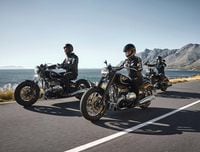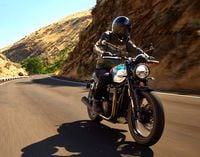The National Highway Traffic Safety Administration (NHTSA) has released the final figures for U.S. motorcycle traffic crashes and related issues in the form of its 2004 Traffic Safety Facts publications.
In terms of basic numbers, the latest reports show pretty much what the initial report and reports from previous years have revealed. Here are the highlights:
- 4008 motorcyclists died in crashes on U.S. roads in 2004
- That's 9% of U.S. traffic fatalities for 2004
- Motorcycling deaths have climbed every year since 1997 along with the fatality rates per bike registered and per estimated mile ridden
- California and Florida lead the league in deaths, with 432 each in 2004.
- Motorcyclists are about 32 times more likely to be involved in a fatal accident than drivers of other vehicles
- Motorcyclists who get dead are more likely to have been drinking than those who die in other vehicles
- Approximately 76,000 motorcyclists were reported injured in crashes on U.S. roads in 2004
Riders in the over-40 age group have trended steeply upward in the crash statistics during the past decade. That fact has been widely bemoaned and theorized about, but we don't know if those older riders are crashing more than other other age groups per mile ridden.
Some numbers from the NHTSA report are worth consideration by any street rider:
- Collisions with other vehicle made up 51% of 2004's fatal accidents.
78% of the riders involved in two-vehicle fatal accidents were struck from the front, and only 6% were struck from the rear. In other words, seeing what's out in front of you and being seen by the drivers out there are critical.
24% of motorcyclists involved in fatal crashes did not have motorcycle licenses. That's about twice the rate for other vehicles. Consider it a warning to get trained and licensed and also not to loan your bike to your unlicensed friends.
As always, riding after drinking is extremely hazardous to your health. On weekend nights, 60% of riders who crashed and died without any outside help had blood-alcohol contents (BACs) of .08 grams per deciliter (g/dL) or greater. A third (34%) of all motorcyclists who died riding had some BAC, even though they weren't necessarily legally drunk.
The NHTSA always includes estimates of lives that helmet use saved. It uses 37% helmet effectiveness in preventing fatal head injuries, a number which the anti-helmet camp certainly has trouble accepting. Using that number, the NHTSA estimates that helmets saved over 1300 lives in 2004 and that universal use of DOT-spec helmets would have prevented half again that many deaths.
A third of fatally injured motorcyclists were thought to have been speeding prior to their crashes. That's about twice the rate of drivers of other vehicles.
For more breaking motorcycle news, visit the home page of www.MotorcycleCruiser.com.
/cloudfront-us-east-1.images.arcpublishing.com/octane/DTN6JPXIQJFXPBR43K4GWBDYJ4.jpg)
/cloudfront-us-east-1.images.arcpublishing.com/octane/PDJNVOWK5VFEBKBUG32CWZEAFI.jpg)
/cloudfront-us-east-1.images.arcpublishing.com/octane/URZBW5LIV5BIXMBTOKHIDHMIPM.jpg)

/cloudfront-us-east-1.images.arcpublishing.com/octane/6KKT5NNL2JAVBOXMZYS5ZO76YA.jpg)
/cloudfront-us-east-1.images.arcpublishing.com/octane/H6Z2IC7WYRBXZNQS4MI3SZ5KPQ.jpg)
/cloudfront-us-east-1.images.arcpublishing.com/octane/IWO5T5PBT5E4HFQ5GK47H5YXR4.jpg)
/cloudfront-us-east-1.images.arcpublishing.com/octane/OQVCJOABCFC5NBEF2KIGRCV3XA.jpg)
/cloudfront-us-east-1.images.arcpublishing.com/octane/F3O2DGLA4ZBDJGNVV6T2IUTWK4.jpg)
/cloudfront-us-east-1.images.arcpublishing.com/octane/ZXYQE3MHLFDSPKNGWL7ER5WJ4U.jpg)
/cloudfront-us-east-1.images.arcpublishing.com/octane/RDF24VM7WVCOBPIR3V3R4KS63U.jpg)
/cloudfront-us-east-1.images.arcpublishing.com/octane/W7RSIBFISNHJLIJESSWTEBTZRQ.jpg)
/cloudfront-us-east-1.images.arcpublishing.com/octane/AERA26ENRNBW3K324YWCPEXYKM.jpg)
/cloudfront-us-east-1.images.arcpublishing.com/octane/YWX3YX7QBBHFXFDMEEEKRG4XJE.jpg)
/cloudfront-us-east-1.images.arcpublishing.com/octane/I7OKI53SZNDOBD2QPXV5VW4AR4.jpg)
/cloudfront-us-east-1.images.arcpublishing.com/octane/IH52EK3ZYZEDRD3HI3QAYOQOQY.jpg)
/cloudfront-us-east-1.images.arcpublishing.com/octane/K2FSAN7OWNAXRJBY32DMVINA44.jpg)
/cloudfront-us-east-1.images.arcpublishing.com/octane/G4XK7JL24FCUTKLZWUFVXOSOGE.jpg)
/cloudfront-us-east-1.images.arcpublishing.com/octane/JJNXVAC27ZCDDCMTHTQZTHO55Y.jpg)




